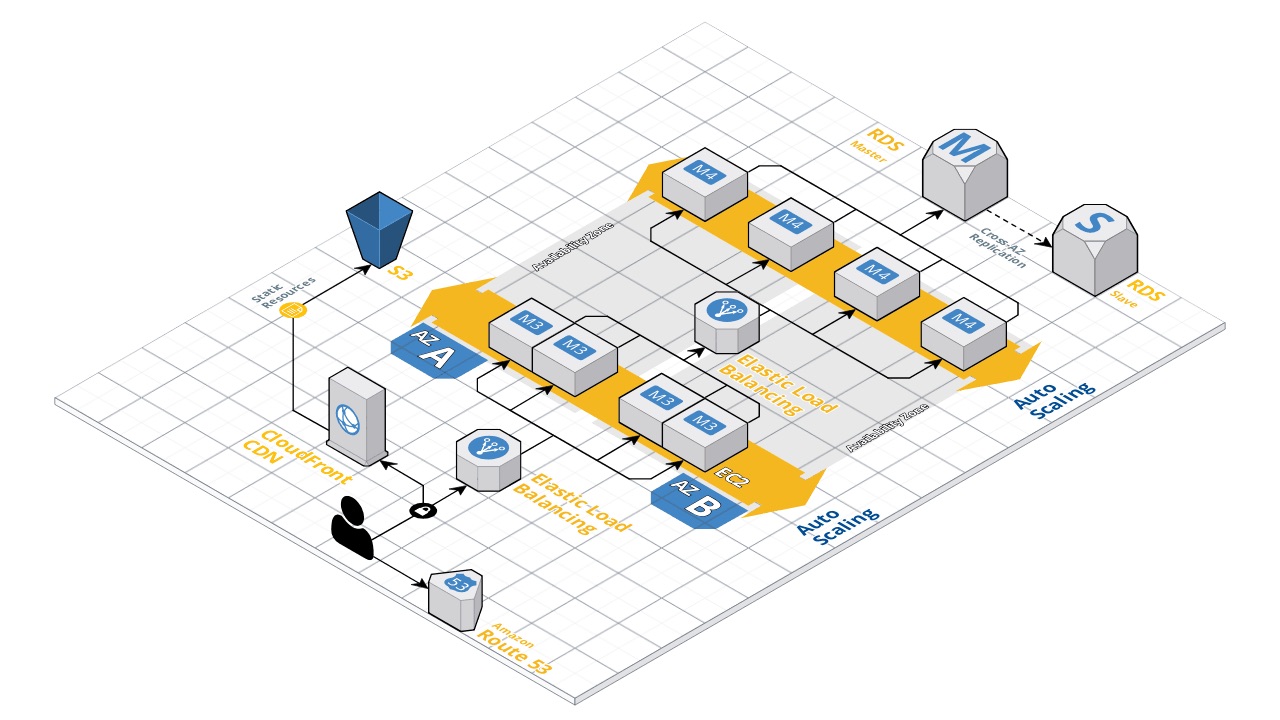We all know how complex apps this days can get, so that is why I created this.
It is just minor contribution to help you achieve "The Basic Web App Architecture", which looks something like the image below.
This is an example repository that you can use to kickstart your project or to make your current project better with some of the ideas included here.
The main purpose is to show one of the many possible ways you could manage your infrastructure using an Infrastructure as Code (IAC) tool like Terraform and a continuous integration tool like CircleCI.
I have followed many of the good practices described in the book Terraform: Up & Running and in the CircleCI 2.0 Documentation. I will also assume you have some knowledge about those tools and Amazon Web Services in general, no need to be an expert.
Assuming you have two environments, production and staging, when a new feature is requested you branch from staging, commit the code and open a PR to the staging branch, when you do, CircleCI will run two jobs, one for linting and one that will plan the changes to your staging infrastructure so you can review them (see image below).
Once you merge the PR, if everything goes as planned CircleCI will run your jobs and will automatically deploy your infrastructure!
After you have tested your infrastructure in staging you just need to open a PR from staging into master to "promote" you infrastructure into production.
In this case we want someone to manually approve the release into master, so after you merge you need to tell CircleCI that it can proceed and it will deploy the infrastructure after the confirmation.
Now that you know what we want to achieve we will dive into the code...get ready!
I will explain each folder in the root level and dive into some of them, in another section I will explain the files contained in each folder (or at least the most important ones).
This folder is where the configuration file for CircleCI is included, it usually
contains one file config.yml. But you can have scripts to do whatever you need to help you run your tests or checks there. In this case we only have one file: config.yml.
It contains a public/private key pair, and before you shout at me, I know you should never have private keys in version control but for simplicity I have included them here.
This folder has one folder for each environment, in this case it has production and staging, but it could have as many as you need! For example if you want each developer to have its own environment they could copy one of those folders and have one new environment, as easy as it sounds!
Each folder has some files that basically wrap the contents of the modules folder.
Here we define all our infrastructure leaving some open parameters for customizing each environment, for example in production you want to run some powerful machines, but for staging you might want low power machines to reduce costs.
This folder has two folders, state which is a module for creating the required resources for managing terraform state remotely, an S3 bucket and a DynamoDB table, which we use in each environment. This is one possibility of the many available. The second folder infrastructure contains the definition of all the infrastructure which we use in each environment.
This folder is for throwing some shared files. In order to use the files we simply create a symbolic link wherever we need to use its contents.
Terraform allows you to create and use modules. That enables us to reuse code.
We have a state module which we use to encapsulate the resources for our backend of choice: S3 Bucket for the state file and DynamoDB for state locking.
The reason to have the state module independent of the infrastructure module is to give us more flexibility, for example, if you want to have one environment per developer they don't need remote storage or locking, they can simply use a local state file. See Terraform Backends for all the alternatives.
Here I have used the module idea to create a infrastructure module that represents everything that is needed to run our apps, that means that every time you use that module you get an exact copy of your infrastructure.
In this repo I use it to create different environments, but you could also use it for creating your custom version of Heroku's Review Apps
This module is only glue for the modules it includes, in the modules/environment/main.tf file we glue the network, instances and databases modules.
It represents the "cables" of our infrastructure, it only has one variable that is the name of the environment.
It outputs some other variables like the CIDR Blocks of the network, the ID of the VPC, and IDs of the public and private subnets.
This was inspired by AWS VPC with Public and Private Subnets
This module receives as input the current environment, the IDs of the private subnets and creates the required resources for a Multi AZ highly available database instance.
After creating the module it exports the endpoint of the database and some other data.
Notice that here we have some VERY DUMMY user and password. Ideally after you create a database you either change the password or manage the passwords in an external way.
The instances module represents the VMs that will be running the code, in this case I also include an AWS Application Load Balancer
As part of the creation of the instances I have used some Terraform Provisioners to execute some commands and create a dummy app to test that everything is working as expected.
terraform-with-circleci-example is licensed under the MIT license.
See LICENSE.md for the full license text.
- Icons made by Gregor Cresnar from www.flaticon.com is licensed by CC 3.0 BY
- WyeWorks for allowing me to create 40% of this repository during my working hours as part of the Continuous Learning policy




